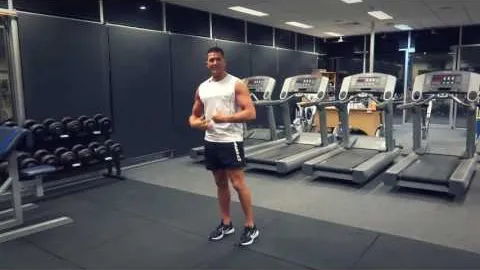

If you're looking for a simple yet effective exercise to strengthen and tone your glutes, look no further than the butt kick exercise. This exercise specifically targets your gluteal muscles, helping you achieve a toned and firm backside.
The butt kick exercise offers a wide range of benefits, making it a popular choice among fitness enthusiasts. Here are some of the key advantages of incorporating butt kicks into your workout routine:
Glute Activation: Butt kicks primarily target your gluteal muscles, helping to activate and engage this often-underused muscle group. Strong glutes are essential for maintaining good posture and preventing lower back pain.
Leg Strengthening: This exercise not only targets your glutes but also works your hamstrings and quadriceps, effectively strengthening your entire lower body.
Cardiovascular Endurance: When performed at a moderate to high intensity, butt kicks can elevate your heart rate, providing a cardiovascular workout that improves endurance and burns calories.
Improved Balance and Coordination: Butt kicks require you to maintain stability while performing the kicking motion, which helps enhance your balance and coordination skills.
Follow these step-by-step instructions to perform butt kicks correctly:
Warm-Up: Before starting any exercise, it's essential to warm up your body to prevent injury. Perform a few minutes of light cardio, such as jogging or jumping jacks, to get your muscles warm and your heart rate up.
Start Position: Stand tall with your feet hip-width apart, arms relaxed by your sides.
Kicking Motion: Begin by jogging in place, focusing on lifting your heels towards your glutes with each step. Aim to bring your heel as close as possible to your glutes, feeling a contraction in your glutes and hamstrings.
Breathing: Breathe steadily throughout the exercise, exhaling as you kick your heels up and inhaling as you lower them back down.
Pace and Intensity: Start with a slower pace to ensure proper form and gradually increase your speed as you become more comfortable. Alternatively, you can add intensity by incorporating butt kicks into a high-intensity interval training (HIIT) workout.
Repetitions and Sets: Aim for 3 sets of 15-20 repetitions per leg, or adjust the number of sets and repetitions according to your fitness level.
To maximize the effectiveness of your butt kick exercise and minimize the risk of injury, keep the following tips in mind:
Posture: Maintain a tall and upright stance throughout the exercise, engaging your core for stability.
Controlled Movements: Focus on controlled movements rather than speed. Keep your kicking motion controlled and deliberate, squeezing your glutes at the top of each kick.
Avoid Knee Hyperextension: Be mindful of your knee joint and avoid forcefully extending your knee at the top of the kick. Instead, focus on the contraction in your glute muscles.
Maintain Balance: As you kick your heels up, be conscious of your balance. If needed, perform this exercise near a sturdy object, such as a wall or a chair, to provide extra support.
Modify Intensity: If you're just starting or have any existing knee or hip issues, consider performing a modified version of butt kicks by kicking your heels backward at a lower height.
Now that you know how to perform butt kicks correctly, it's time to incorporate them into your fitness routine. Here are a few ways to do so:
Warm-Up: Use butt kicks as a dynamic warm-up exercise before engaging in activities such as running, cycling, or weightlifting. This will help activate your glutes and prepare your body for the workout ahead.
Cardio Circuit: Combine butt kicks with other cardio exercises, such as jumping jacks, high knees, or burpees, to create an intense cardiovascular circuit. This will elevate your heart rate while simultaneously targeting your glutes and lower body muscles.
Strength Training: Add butt kicks to your leg and glute-focused strength training routine. Perform them between sets of squats, lunges, or deadlifts to further activate your glutes and intensify your workout.
HIIT Workouts: Incorporate butt kicks into high-intensity interval training (HIIT) workouts. Alternate between short bursts of maximum effort butt kicks and active recovery exercises, such as jogging in place or walking.
The butt kick exercise is a versatile and effective workout that specifically targets and tones your gluteal muscles. By incorporating butt kicks into your fitness routine, you'll not only strengthen and tone your glutes but also improve your overall lower body strength, cardiovascular endurance, balance, and coordination. Remember to maintain proper form, gradually increase your intensity, and always listen to your body to avoid injury. So, start kicking those heels and enjoy the benefits of this fantastic exercise!
If you're looking for a gym, fitness club or yoga studio, you've come to the right place.
You can find information about gyms in your area. Browse catalog of gyms and find gyms with classes which are you looking for.
On gym page you can find simple information like address, phone or website. You can find list of available classes. You can check availability of personal training or small group classes. On place page you can also see information about open hours.
You can find gyms near you with amenities, courts, studios and equipments.
Use our map to find gym at your city or district.
In Gym Navigator you can find list of exercises with movies for many body parts.
You can browse exercises catalog and find exercises the best of you.
You can also find exercises grouped into workout plans, which you can use to improve you body. Each routine show you exercises one by one and give you possibility to count you progress and count down rest time.